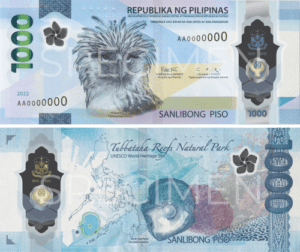Is it time to stop folding bills of money?
A netizen recently expressed her disappointment online when it was claimed that a well-known mall in the nation refused to accept a folded 1,000 peso polymer banknote that she used for a transaction. The original social media post was reshared by numerous other people and pages, and although though it can no longer be viewed, it quickly went viral.
“Don’t keep fresh 1,000 peso money around! It shouldn’t have folds, according to the mall’s management, Facebook user Reylen Lopez wrote in Filipino on the original social media post.
“The mall wouldn’t take the banknote I was intended to use as payment. We didn’t receive a heads-up. Is it just me who is unaware of this? ”
How should polymer banknotes be handled?
The P1,000 banknote introduced in April is constructed of polymer as opposed to the nation’s current paper banknotes, which are made of paper substrate with a 20 percent abaca and 80 percent cotton blend.
According to Bangko Sentral ng Pilipinas (BSP) Deputy Governor Mamerto Tangonan, “It is no longer paper; it is plastic.”
Proper Handling of Polymer 1000 Bill
- Maintain Flat Bills by Placing Polymer Banknotes in Wallets Long Enough for the Bills to Fit Properly.
- Keep them clean by wiping down polymer banknotes that are soiled or unclean with a moist cloth. Alcohol-based sanitizers can also be used to disinfect the surface, but they must be promptly followed by wiping it with a dry cloth.
- Do not hoard polymer banknotes; instead, use them to pay for goods and services. Additionally forbidden are the higher price purchases or sales of them.
What to avoid?
People should keep in mind these don’ts when handling P1,000 polymer banknotes, just as they would with paper currency:
- The new bills must not be marked, written on, or defaced.
- Avoid overly folding, crinkling, or crumpling polymer banknotes because doing so could result in permanent stains.
- Do not rip, cut, or puncture it.
- Rubber bands or staples should not be used to bind polymer banknotes. Instead, use paper bands.
- Do not tamper with the polymer banknotes’ transparent windows, metallic accents, or other security features.
- Polymer banknotes should not be ironed.
- Avoid placing them close to an open flame or exposing them to extremely high temperatures.
- Avoid exposing polymer banknotes to potent or corrosive agents like bleach or muriatic acid.
According to Presidential Decree No. 247, it is illegal for anybody to wilfully tamper with, mutilate, shred, burn, or otherwise destroy BSP currency notes and coins in any way (still Central Bank of the Philippines when the decree was issued).
Anyone found guilty of violating this decree faces a maximum fine of 20,000 pesos (P20,000) and/or a maximum sentence of five years in prison, it continued.
Composition of Paper Bills
The New Generation money series, which dates from 2010 to the present, is constructed of paper with:
- Cotton blend – 80%
- Abaca – 20%
Philippine Paper and Polymer Banknotes: Differences
The faces on the regular 1,000 peso bill are Jose Abad Santos, Vicente Lim, and Josefa Llanes Escoda, while the Philippine Eagle is the main feature of the new polymer notes. Both paper and polymer currency include a picture of the Tubbataha Reef on the back. However, the BSP and Philippine government seals are present on the new polymer banknote.
Thoughts
We respect our Filipino culture and our country’s emblems by keeping these instructions in mind. Additionally, by following these suggestions and keeping them in mind, we thank those who receive our money by giving them crisp, clean, sterilized bills that are prepared for usage by the entire country.
We also acknowledge the importance of money and the work that went into developing the 1000 peso bill. Users are given the opportunity to appreciate the symbolism included in the designs and place value on its visuals. Additionally, don’t fold the bill, as our grandparents and grandmothers have instructed us to do.
It shows respect for it, but culturally, it conforms to the idea that managing your physical money brings you “good luck.”
The new 1000 peso polymer currency won’t be demonetized either, according to the Banko Sentral ng Pilipinas, and will continue to be worth 1000 pesos. This must be kept clean in order for it to be accepted in establishments where you must make a purchase and make payment.
On April 18, 2022, President Rodrigo Duterte presented 50 uncut pieces of 1000 peso uncut polymer bills, resulting in the release of this denomination.
Another reminder is that money should be used and passed on rather being retained and stored for a long time so that it can be distributed across the country. It is not intended to be “hoarded” or stored indefinitely, and also, according to an article, the present 1000 peso bill is still in use and is used to make payments to individuals, organizations, and other entities in a variety of activities.





